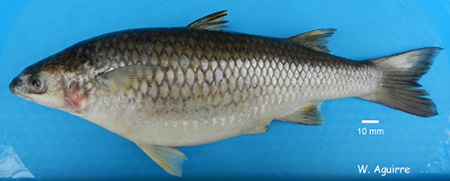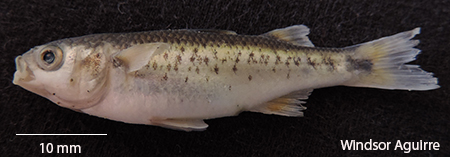Mugilidae - Agonostomus monticola (Baneroft, 1836) |
 |  |
| Left: Adult fish market specimen from Esmeraldas drainage. Right: Juvenile wild caught specimen from Esmeraldas drainage. |
| SOURCE FOR OCCURRENCE IN ECUADOR: This species occurs along thePacific drainages and the Galapagos Islands (e.g., Barriga, 1991; Eschmeyer and Fricke, 2012). |
| ORIGINAL DESCRIPTION: Griffith, E., & Smith, C. H., in Griffith & Smith 1834:367, Pl. 36 (opp. p. 366) [The class Pisces, arranged by the Baron Cuvier; ref. 1908] Jamaica. No types preserved. Author is E. N. Bancroft. Name available from Pl. 36 (vernacular only on p. 367). |
| TYPE SPECIMENS: |
| TAXONOMIC STATUS: Valid (Eschmeyer and Fricke, 2012). |
| RANGE ECUADOR: Northwestern Ecuador (Barriga, 1991) and rivers along Pacific coast including the Valdivia River in the communal reserve “Loma Alta” (Santa Elena province). |
| RANGE OUTSIDE OF ECUADOR: North, Central and South America; Atlantic, Caribbean and Pacific drainages (Eschmeyer & Fricke, 2012). |
| COLLECTIONS IN ECUADOR: |
| MAXIMUM SIZE: 31.2 cm total length (Eslava & Díaz, 2011). |
| DISTINGUISHING FEATURES: Agonostomus monticola has an elongate cylindrical body, large, terminal mouth, convex predorsal profile, pelvic fins in an abdominal positions, dorsal coloration is gray, sides are silver and ventral coloration is white (Bussing, 1998). |
| ECOLOGY: Agonostomus monticola, known in Ecuador as the “lisa de montana” (mountain mullet), is a medium, ecologically important carnivorous fish that feeds on crustaceans and insect larvae (Bussing, 1998). |
| ECONOMIC IMPORTANCE: A species with no commercial importance. |
| CONSERVATION STATUS: NA, although the species is not heavily exploited as a food species. |
| LINK TO FISHBASE PAGE: Click here for link |
| SPECIES PROFILE CREATED BY: Enrique Laaz. |
| SPECIES PROFILE CONTRIBUTORS: Windsor Aguirre. |
|
|
|
|
|

